
Crete Island
The Island of Crete is the biggest and the southest island of Europe and is the biggest Island in Greece, but….in the south of Crete Island, there is a smallest island called Gavdos, indeed that island is the southest island of Europe.
Crete is 160 km (99 mi) south of the Greek mainland.
Crete is 260 km (160 mil)long,60km (37mil) at It’s widest point,from Heraklion to South,and 12km(7.5mil)at It’s narrowest point in Ierapetra.
and It’s coastline is 1,046 km (650 mi).
The area of the island of Crete is 8336 sq km (3.219sq mil)
Crete Island population,is around 700.000
The capital of Island is Heraklion,located in the centre,north of Island,with population approximately 170.000.
Chania 110.000
Rethimno 56.000
AG Nikolaos 28.000
Ierapetras 28.000
Sitia 19.000
Oropedio Laisithi 2.400
The highest point of the island is Mount of Psiloritis with 2456m.
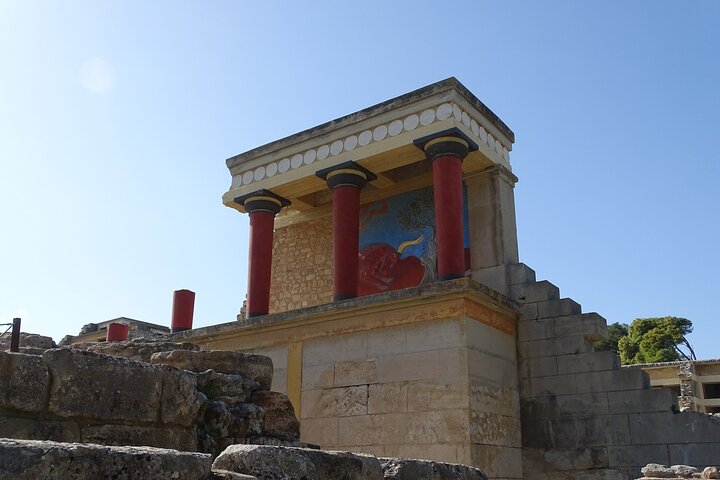
Knossos Palace -Heraklion
The Knossos Palace is an ancient archaeological site located on the island of Crete in Greece. It was the center of the Minoan civilization, which flourished from around 3000 BC to 1100 BC. The palace was discovered in the early 20th century by archaeologist Arthur Evans, who excavated and reconstructed the site.
The palace complex covers an area of over 20,000 square meters and consists of multiple courtyards, chambers, and halls, as well as various residential and storage areas. The layout of the palace is intricate and labyrinthine, with many rooms and corridors interconnecting in a complex maze-like design.
One of the most notable features of the palace is the throne room, which is adorned with vibrant frescoes depicting mythical creatures and scenes from Minoan life. The palace also contains a number of storerooms, which held vast quantities of food, wine, and other goods.
It is believed that the Knossos Palace was not just a royal residence, but also served as a cultural and economic center for the Minoan civilization. The palace likely played a key role in the production and distribution of goods such as pottery, textiles, and metalwork, as well as in religious ceremonies and rituals.
Today, visitors to the Knossos Palace can explore the site and view the many reconstructed rooms and frescoes, gaining a glimpse into the fascinating world of the ancient Minoan civilization.

Vai Palm Beach -Sitia
Vai Beach, also known as Palm Beach, is a beautiful sandy beach located on the eastern coast of Crete, Greece. The beach is renowned for its natural palm grove, which is a rare sight in Europe. The palm trees, along with the crystal-clear waters, create a stunning tropical-like atmosphere that is unique to Vai.
The beach is approximately 200 meters long, and the sand is soft and golden. The water is shallow and calm, making it ideal for swimming and other water activities such as snorkeling and diving. The beach is also equipped with umbrellas and sunbeds for visitors’ comfort.
Apart from the stunning natural beauty, Vai Beach also has a rich history. It is believed that the palm grove was created by Phoenician traders who threw their dates’ pits on the beach. Later, the palm trees were cultivated by the monks who built a monastery nearby.
Today, Vai Beach is a popular tourist destination, attracting thousands of visitors every year. However, despite its popularity, the beach remains unspoiled and maintains its natural charm. It is the perfect place to relax, unwind, and soak up the Mediterranean sun.

Heraklion Koules Fortress (Rocca a Mare)
Heraklion is a coastal city located on the northern coast of the Greek island of Crete. It is the largest city and the administrative capital of the island. With a rich history dating back to ancient times, Heraklion is a popular destination for tourists who come to explore its museums, archaeological sites, and vibrant nightlife.
One of the main attractions in Heraklion is the ancient Palace of Knossos, which is considered one of the most important archaeological sites in Europe. This palace was the center of the Minoan civilization, which flourished on Crete more than 3,000 years ago. Visitors can walk through the palace’s impressive ruins, which include colorful frescoes and intricate stonework.
Another must-see attraction in Heraklion is the Archaeological Museum of Heraklion, which houses an extensive collection of Minoan artifacts. The museum’s exhibits include pottery, jewelry, and statues that date back to the Bronze Age. Visitors can also see items that were excavated from the Palace of Knossos, including the famous Bull’s Head Rhyton.
In addition to its ancient history, Heraklion is also known for its bustling city center. The city’s main pedestrian street, 25th August Street, is lined with shops, cafes, and restaurants, and is a popular spot for locals and tourists alike. Heraklion also has a vibrant nightlife scene, with many bars and clubs that stay open until the early hours of the morning.
For those who want to relax and soak up some sun, Heraklion has several beautiful beaches nearby. Amoudara Beach is one of the most popular, with its long stretch of golden sand and crystal-clear waters. Visitors can rent umbrellas and lounge chairs, and there are also several beachfront bars and restaurants.
Overall, Heraklion is a city that offers a mix of ancient history and modern culture. Whether you’re interested in exploring the island’s past, enjoying the local cuisine, or simply soaking up the Mediterranean sun, Heraklion has something to offer everyone.
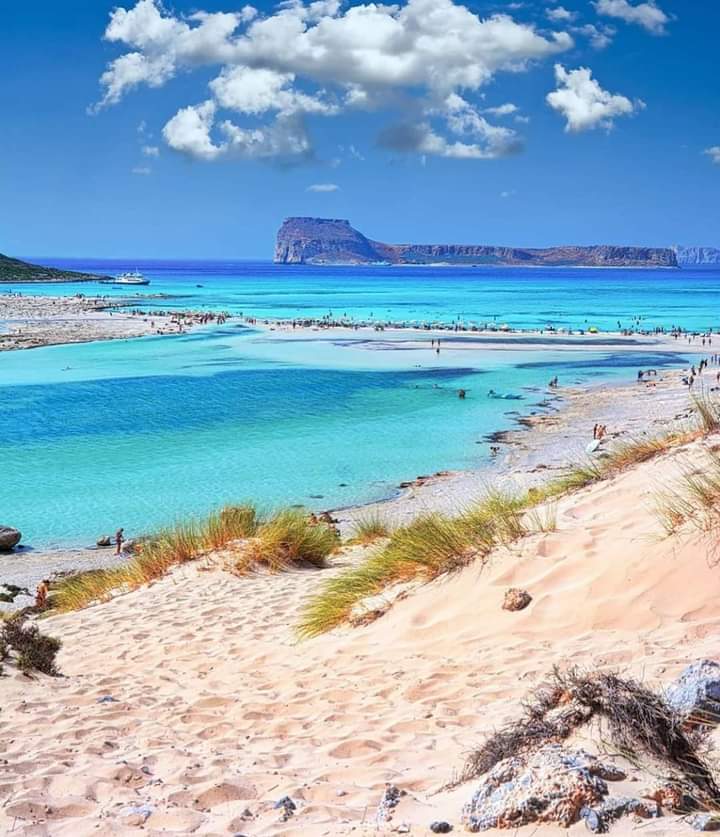
Balos and Gramvousa
Gramvousa is a small island located off the coast of northwestern Crete, in the region of Chania. It is known for its beautiful beaches, crystal clear waters, and stunning natural scenery.
One of the main attractions on Gramvousa is the Venetian fortress, which was built on the island in the 16th century. The fortress offers breathtaking views of the surrounding sea and coastline, and visitors can explore its walls and towers while learning about its history and significance.
Another popular activity on Gramvousa is hiking, with several trails leading to scenic viewpoints and secluded coves. The island is also home to a variety of wildlife, including rare bird species and Mediterranean monk seals.
Visitors can reach Gramvousa by boat from the nearby port of Kissamos, and there are several tour operators offering day trips to the island. Whether you’re looking to explore ancient history, soak up some sun on the beach, or simply enjoy the natural beauty of Crete, Gramvousa is definitely worth a visit.
To reach Balos, visitors can either hike or take a boat tour from the nearby town of Kissamos. The hike to Balos is about 8 kilometers long and can be quite challenging, but the views along the way are breathtaking. The boat tour, on the other hand, is a more relaxing way to reach the beach and takes about 30-40 minutes.

Venetian Lighthouse of Chania
Chania Town, located on the western coast of the Greek island of Crete, is a picturesque and charming destination that offers a unique blend of historical and modern attractions.
The town’s Venetian Harbor, built in the 14th century, is a must-see attraction. The harbor is lined with cafes and restaurants, and visitors can stroll along the waterfront and take in views of the colorful fishing boats and historic buildings.
The Old Town of Chania is another highlight, with narrow streets and alleys that are perfect for exploring on foot. The town’s architecture reflects its rich history, with Venetian and Ottoman influences evident in the buildings.
One of the most popular attractions in Chania Town is the Municipal Market, which is housed in a beautiful 1913 building. Here, visitors can browse a wide range of local products, including fresh produce, meat, cheese, and olive oil.
Chania Town also offers plenty of opportunities for outdoor activities, including hiking in the nearby White Mountains, exploring the Samaria Gorge, or relaxing on one of the town’s many beaches.
With its rich history, stunning architecture, and natural beauty, Chania Town is a destination that should not be missed by anyone traveling to Crete.

Lygaria beach in Heraklion
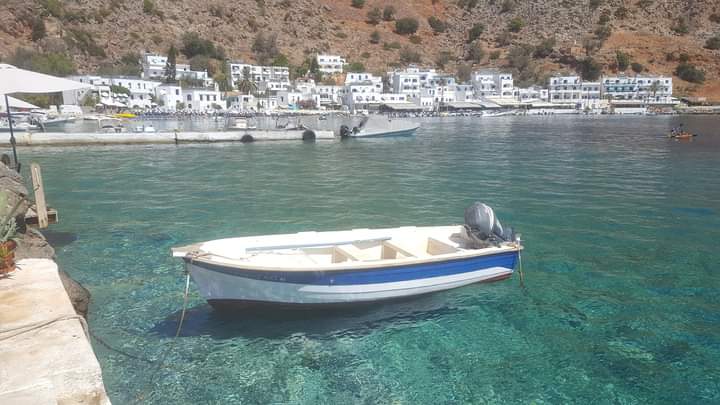
Loutro Village – South of Chania
Loutro is a picturesque village located on the south coast of Crete, Greece. It is accessible only by boat or on foot, as there are no roads leading to the village. Loutro is known for its stunning natural beauty, crystal-clear waters, and relaxed atmosphere.
The village is built on the side of a hill and overlooks a small bay. The buildings are traditional white-washed houses with blue shutters and doors, creating a charming and romantic atmosphere. Loutro is a popular destination for those seeking a peaceful and quiet holiday away from the hustle and bustle of busy cities.
The village has several tavernas and cafes, serving fresh seafood and traditional Greek cuisine. There are also a few shops selling souvenirs and local products. Visitors can enjoy swimming in the clear waters of the bay, sunbathing on the pebble beach, or exploring the nearby hiking trails.
Loutro is also a great base for exploring the surrounding area. Visitors can take a boat to nearby beaches, such as Glyka Nera or Marmara, or visit the nearby villages of Anopolis and Chora Sfakion. The Samaria Gorge, one of Europe’s longest and most impressive gorges, is also within driving distance.
Overall, Loutro is a hidden gem that offers a unique and unforgettable experience to its visitors. Its stunning natural beauty, relaxed atmosphere, and traditional charm make it the perfect destination for those seeking a peaceful and authentic Greek holiday.
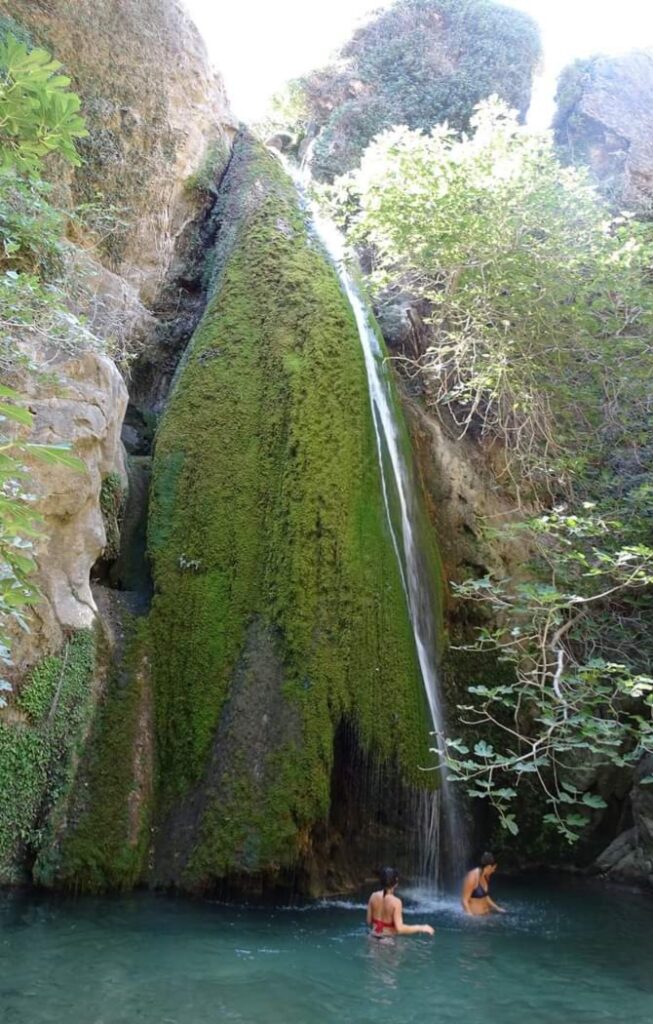
Richtis Gorge – Eastern Crete
Richtis Gorge is a natural wonder located in eastern Crete, Greece. It is a beautiful gorge that stretches over 4 kilometers from the traditional village of Exo Mouliana to the beach of Richtis. The gorge is known for its stunning natural beauty, crystal-clear waters, and rich flora and fauna.
The hike through Richtis Gorge is a popular activity for nature lovers and hikers who want to explore the unspoiled beauty of the Cretan landscape. The trail follows a stream that flows through the gorge, passing by lush vegetation, waterfalls, and small pools where visitors can take a refreshing dip.
Along the way, hikers can admire the wildflowers and herbs that grow in the gorge, including thyme, sage, and oregano. They may also encounter various species of birds and butterflies, such as the colorful swallowtail butterfly.
The highlight of the hike is the Richtis Waterfall, which is located at the end of the gorge. The waterfall is about 20 meters high and cascades into a small pool of turquoise water, creating a magical and peaceful atmosphere.
Visitors can also explore the traditional village of Exo Mouliana before or after the hike. The village is known for its traditional architecture and narrow streets, and it offers stunning views of the Aegean Sea.
Overall, Richtis Gorge is a must-visit destination for those who want to experience the natural beauty of Crete and immerse themselves in the island’s rich flora and fauna.
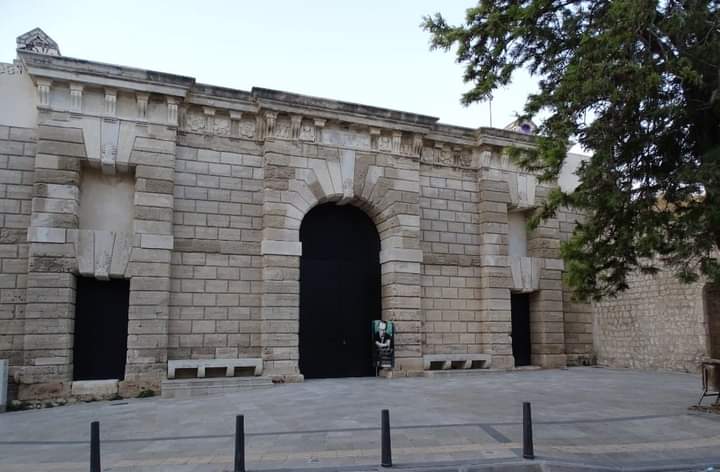
Jesus Gate – Heraklion

Sfendoni cave – Rethymno
Sfendoni Cave is a stunning underground cavern located in the area of Zoniana in the Rethymno region of Crete, Greece. This natural wonder is a must-see for anyone visiting the island, as it offers a unique and unforgettable experience.
The cave was discovered in 1963 by local residents, and since then has been open to the public for exploration. The cave is filled with incredible rock formations, stalactites, and stalagmites that have formed over thousands of years.
Visitors can take a guided tour of the cave, which lasts approximately 45 minutes to an hour. The tour takes visitors through several large chambers, each with their own unique features and formations. Along the way, visitors will learn about the geological history of the cave and how the formations were created.
One of the most impressive sights in the cave is the “Organ Room,” which features a stalactite formation that resembles a pipe organ. The guide will often demonstrate the incredible acoustics of this room by playing music on a small keyboard.
Another highlight of the tour is the “Lake Room,” where visitors can see a small underground lake that reflects the beautiful rock formations above it.
The temperature inside the cave is cool and constant throughout the year, making it a great activity to escape the heat of the summer months. The cave is also well-lit, making it easy to see all of the incredible formations.
Overall, a visit to Sfendoni Cave is a unique and unforgettable experience that should not be missed by anyone visiting Crete.
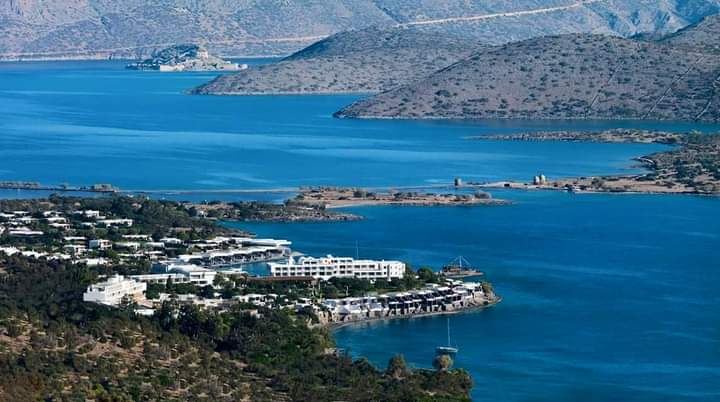
Elounda – Agios Nikolaos
Elounda Village is a charming seaside village located on the northeastern coast of the Greek island of Crete. Surrounded by stunning natural beauty, including crystal-clear waters and majestic mountains, Elounda Village is a popular destination for tourists seeking a relaxing and rejuvenating getaway.
The village is known for its luxurious resorts and villas, as well as its picturesque harbor, where colorful fishing boats bob in the clear waters. Visitors can stroll along the waterfront promenade, browse the local shops and boutiques, or dine on fresh seafood and traditional Cretan cuisine in one of the many tavernas and restaurants.
For those seeking adventure, Elounda Village offers a variety of outdoor activities, including sailing, snorkeling, and diving. The nearby Spinalonga Island, which served as a leper colony until the mid-20th century, is a popular destination for boat trips and tours.

Matala Village – South of Heraklion
Matala is a charming coastal village located on the south coast of Crete, Greece. This quaint town is known for its stunning beaches, crystal clear waters, and the ancient Roman caves carved into the cliffs. A day tour to Matala is an excellent way to explore the natural beauty and cultural significance of this unique destination.
In addition to the beach and caves, there are plenty of other attractions to explore in Matala. You can take a stroll through the village and admire the traditional architecture, browse the local shops and boutiques, or enjoy a meal at one of the many restaurants and cafes.
Whether you’re looking to relax on the beach, explore ancient ruins, or go on an adventure, Matala has something for everyone. Come and experience the magic of this beautiful village for yourself!

Rethymno
Rethymno is a picturesque town located on the north coast of the island of Crete in Greece. It is the third largest town in Crete and has a rich history dating back to the Minoan era. The town is known for its stunning beaches, Venetian architecture, and lively atmosphere.
The old town of Rethymno is a maze of narrow streets and alleys lined with Venetian buildings that reflect the town’s rich history. The most famous landmark of the old town is the Venetian Fortezza, a massive fortress built in the 16th century to protect the town from pirates and invaders. The old town is also home to numerous museums, art galleries, and shops selling traditional Cretan products such as olive oil, honey, and handmade ceramics.
The town’s beaches are among the best in Crete, with crystal clear waters and golden sands. The most popular beach in Rethymno is the 12-kilometer-long sandy beach that stretches along the town’s waterfront. The beach is equipped with sun loungers, umbrellas, and beach bars, and it’s perfect for swimming, sunbathing, and water sports.
Rethymno is also famous for its nightlife, with numerous bars, clubs, and taverns that stay open until the early hours of the morning. The town’s traditional taverns serve delicious Cretan cuisine, including fresh seafood, grilled meats, and local cheeses.
If you’re interested in history and culture, Rethymno is the perfect place to explore the rich heritage of Crete. The town has a long and fascinating history that is reflected in its museums, churches, and archaeological sites. Some of the must-see attractions in Rethymno include the Archaeological Museum, the Historical and Folklore Museum, and the Rimondi Fountain.
Overall, Rethymno is a charming town that offers something for everyone, whether you’re interested in history, culture, nature, or simply relaxing on the beach. With its warm climate, friendly locals, and stunning scenery, Rethymno is the perfect destination for your next vacation in Crete.
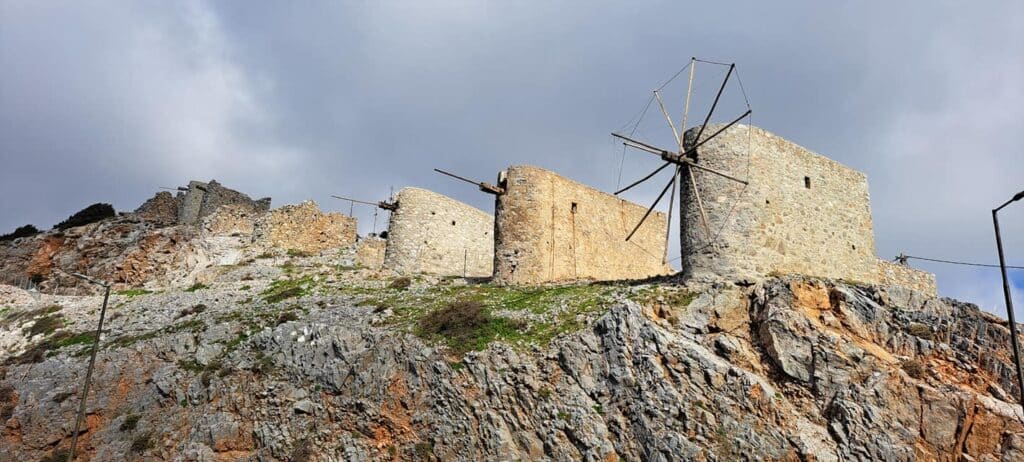
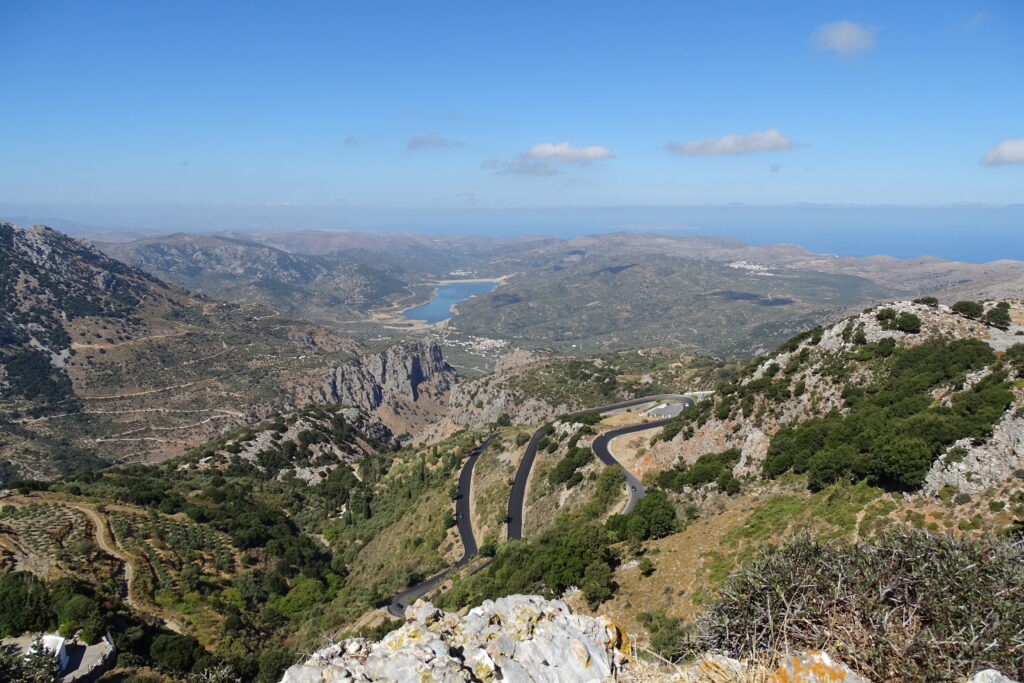
Lasithi Plateau
Lasithi Plateau is a beautiful and picturesque highland plain located in the eastern part of the Greek island of Crete. Surrounded by stunning mountain ranges, the plateau sits at an altitude of around 800 meters above sea level and covers an area of approximately 25 square kilometers.
The plateau is known for its fertile soil and is home to many small villages that specialize in agriculture, particularly the cultivation of potatoes. Visitors can enjoy the sight of traditional windmills that dot the landscape, used for irrigation purposes.
One of the main attractions of the Lasithi Plateau is the Dikteon Cave, which is said to be the birthplace of Zeus, the king of the Greek gods. The cave is located on the slopes of Mount Dikte and is a popular spot for tourists to explore.
There are also several hiking trails in the area that offer stunning views of the surrounding mountains and valleys. Visitors can take a leisurely stroll through the quaint villages, visit the local tavernas to sample traditional Cretan cuisine, or simply enjoy the peace and tranquility of the countryside.
Overall, the Lasithi Plateau is a must-visit destination for anyone traveling to Crete, offering a unique glimpse into the island’s rich history, culture, and natural beauty.
If you are planning to explore Lasithi Plateau we can book a tour with Tours in Heraklion

